Forum Replies Created
-
AuthorPosts
-
 Keith TaylorParticipant
Keith TaylorParticipant
Brian, there’s absolutely no need to apologize. Because we never really know the right questions to ask until we know the answers! So, that’s a paradox we can only solve by chatting and getting to know each other better.
If anything, it’s your doctor who should know better. Because I believe doctors should be clearer at explaining uric acid test results. After all, every gout patient should have a target for uric acid. Then, you know that after 6 months at your target, you are well on the way to permanent gout recovery. So, it’s important, but we can wait until next week.
However, if you have more questions about your gout during the weekend, please ask them. Because the only dumb gout question is the one you didn’t ask! 🙂
 Keith TaylorParticipant
Keith TaylorParticipantHi Brian,
I know the gout diagnosis is a shock to you. But, you are not alone. Because my nephew got his gout diagnosis slightly younger than you. Also, thousands of others get the same problem in their twenties rather than forties or later. So, it just means you can learn to manage it now, rather than later when it’s harder to cope.
Firstly, I think you have to focus on uric acid. Because alcohol at your intake is not the problem. So, you can study alcohol and gout if you want. But, my experience is that 4 whiskeys a night is not going to have a huge impact. Unless you’re talking bottles! However, the current medical advice is to not drink every day, though that’s general health rather than gout.
You say your uric acid is “elevated”. But, that doesn’t really mean anything. Because with uric acid, exact numbers matter. So, whatever your number is now, you have to get it below 5mg/dL. Or, if you have other medical issues, you might have to settle for 6mg/dL.
Secondly, be careful with baking soda for gout.
I can give you a better idea about better ways to fix your gout if I know your uric acid number. But, if you want to do some research yourself, its best to start with what type of gout sufferer are you.

Let’s learn about your gout together.
 Keith TaylorParticipant
Keith TaylorParticipantHey Gary,
I’m pleased that your gout recovery is progressing well. Also, I can’t wait to read your latest uric acid blood test results. 😀
 Keith TaylorParticipant
Keith TaylorParticipantNobody, just to be clear, are you saying that if you take 1mg colchicine during a gout flare it gets worse after an hour, yet taking a higher dose makes gout pain the same or slightly less in an hour? My choice of an hour is just random. It might make more sense to say half an hour.
 Keith TaylorParticipant
Keith TaylorParticipantThere is a way that ice can benefit gout pain. Without adding to uric acid crystals. Because it can be very effective if you follow ice treatment with a warm compress.
Firstly, apply an ice pack to the affected area. Then, you should notice a reduction in gout pain and swelling. After that wrap the affected area in a warm towel, or apply a warm compress. But remember what a compress is! Because it is not a compression device, as I noted recently in an update to Heat Or Ice For Gout Relief.
 Keith TaylorParticipant
Keith TaylorParticipantTo answer my own question….
In my opinion, gout cannot be contagious. Because it is only excess uric acid that causes gout. Then, when we lower uric acid to safe levels, gout symptoms stop. So, I think belief in infectious gout is out of date. But, there is one dangerous aspect of infection that we can link to gout.
Gout diagnosis is usually very easy. But, sometimes, a disease can mimic gout. Then that can lead to wrong treatments. As is the case with Septic Arthritis.
I don’t know how many cases of septic arthritis occur each year. But, it is definitely a disease that can be contagious. To explain, I looked at a case where the patient had both gout and septic arthritis. Because it highlights the dangers:
For septic arthritis of the knee, such managements as intravenous infusion of antibiotics, surgical treatment of local tissues affected and immobilization of the affected joint will result in satisfactory effects. In contrast, improper surgical treatment and abuse of antibiotics will worsen knee joint infection, and even cause infection spread and death.
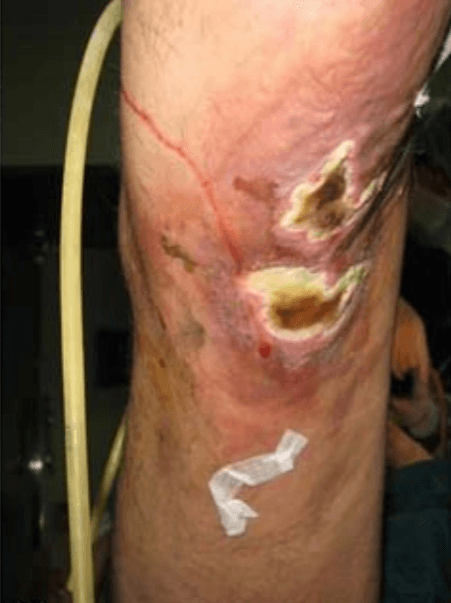
Contagious Septic Arthritis Mimics Gout
Septic Arthritis References
[1] Duan, Xiaojun, Liu Yang, and Peiyuan Xia. “Septic arthritis of the knee caused by antibiotic-resistant Acinetobacter baumannii in a gout patient: a rare case report.” Archives of orthopaedic and trauma surgery 130.3 (2010): 381-384. Keith TaylorParticipant
Keith TaylorParticipantMy best guess is you read your uric acid blood test result wrong. I imagine it actually says 0.43mm/L or 430μmol/L. Or, sometimes people look at urea, which is something else.
If you like, Gary, I can check this for you. Just take a photo of your uric acid blood test result. Then attach it to the feedback form below. Or save it in Dropbox, Gdrive, or similar and send the link.
 Keith TaylorParticipant
Keith TaylorParticipantIt’s complicated d_q!
First, my information that supports tomatoes for gout is far from perfect. My gazpacho soup report might oversimplify the situation. Because it features onions which are a recognized for lowering uric acid. So, the positive effects of gazpacho soup might me onion-related. But, more recent tomato-uric acid research finds in favor of tomatoes, when one whole tomato is consumed before a meal.
So, we have 2 studies that support tomatoes for gout. Then there is the New Zealand study. But, in my opinion, that study is fatally flawed. However, to present balanced information, I need to rewrite my tomato article to reflect all the available science. Then, I can add my opinions after.
To explain, the New Zealand study quite clearly states that it includes consumption of tomato and tomato products. That specifically excludes ketchup. But, I know from experience that the tomato products available in the states are extremely high in salt. Also, when I looked at the top-selling brands of juice, many of the popular brands included lashings of MSG and HFCS. So, expect a rewrite before the end of the month.
But the most important aspect of this debate struck me today. Because I feel it is a particularly pointless topic.
My reason is that any sensible gout sufferer will be actively working towards safe uric acid. Then, once uric acid is safe, it does not matter if you eat tomatoes or not. So, in my mind, it’s a personal decision.
In conclusion: if any gout sufferer does not feel safe with tomatoes, then stop eating them for a few months!

Are Cherry Tomatoes Good for Gout?
 Keith TaylorParticipant
Keith TaylorParticipantHey Andrew ( @andrew-kelsey ),
Have you found where we put “Your website says to take no more than one capsule a day.”? We would like to correct it. Because you should take colchicine every day, as a preventative. But, some gout patients take it as required at the first sign of gout.

 Keith TaylorParticipant
Keith TaylorParticipantReturning to colchicine dosing, I still struggle to accept that it has any anti-inflammatory effect. So, I never took more than 2 a day (2 times 0.5 g = 1g/day). But, I did rely on ibuprofen – probably because I was used to it, and never had problems (I remember a nurse saying I had a cast iron stomach. She made no comment about any other part of my anatomy). On a few occasions, I supported ibuprofen with intermediate paracetamol (acetaminophen).
That’s when I came up with my 3-pronged strategy of:
– Stop/slow inflammation spreading (colchicine).
– Reduce inflammation (NSAIDs).
– Block residual pain (paracetamol).Of course, the principles can be applied to different treatment combinations. But, I’m always wary of too much colchicine, based on how it works.
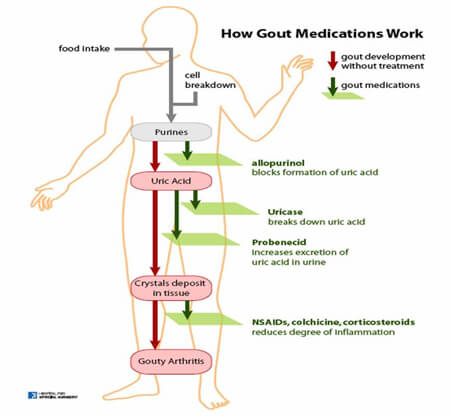
Has anyone experienced anti-inflammatory effects of colchicine?
 Keith TaylorParticipant
Keith TaylorParticipantDon, I hope you’ve taken to heart what nobody wrote. Because it says almost everything you need to think about.
I say “almost” because there is something particularly important that you seem to ignore – your uric acid level.
Gout is not about taking allopurinol every day for life. Although, that suits some gout patients. But, it is about managing uric acid, and gout symptoms. So, in my opinion, you don’t need a gout specialist. You DO need a Don specialist!
That is someone who listens to your needs, monitors your situation, and helps you make the right choices for you. So, you’ve come to the right place.
What’s your uric acid level, Don?
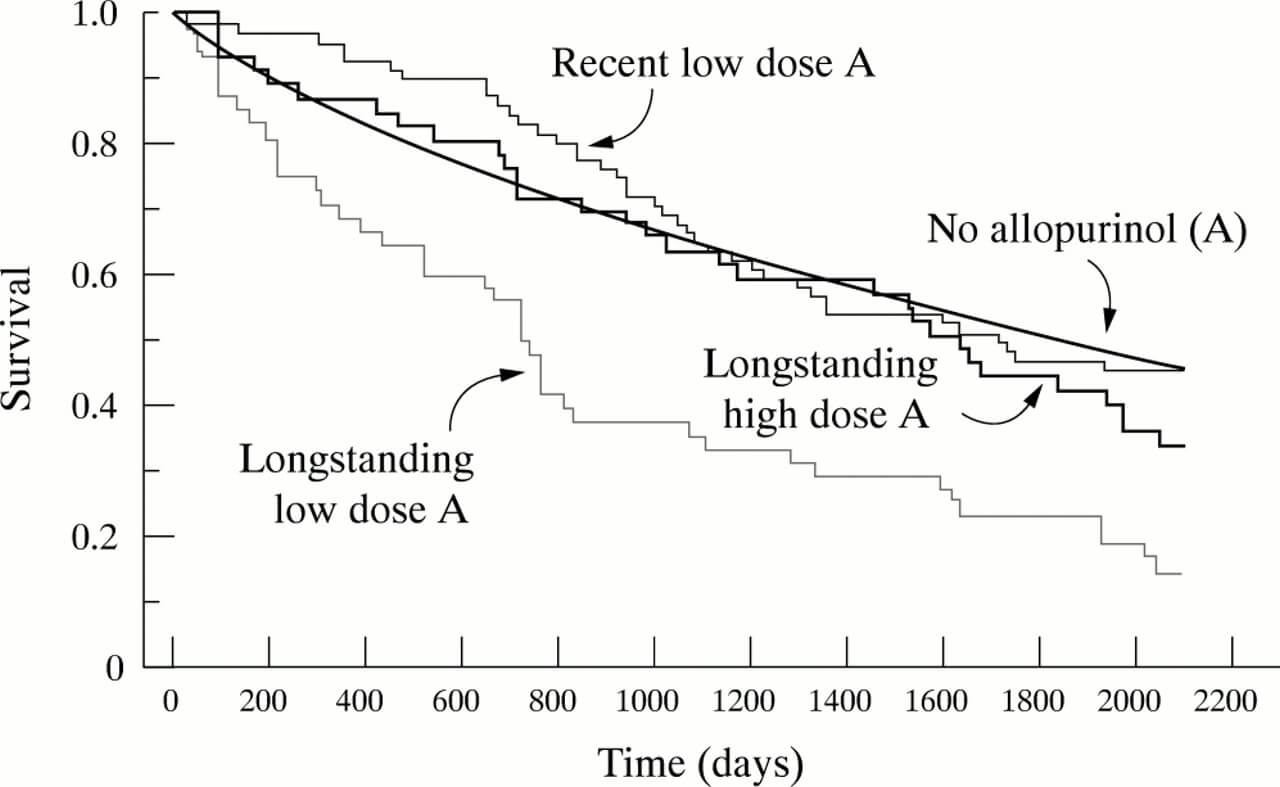
“Long term high dose allopurinol may be associated with a better mortality “
 Keith TaylorParticipant
Keith TaylorParticipantd_q, there’s lots of gouty topics here that are very interesting. So, if I miss a point or two, just give me a mention. Or start a separate topic.
24-hour urine test
Simply collect your pee for a day as a special gift for your doctor. The lab measures the amount of uric acid you excrete. If it is low, uricosuric drugs or food will improve excretion rates. Then that should lower uric acid. Personally, I think it should be law for this test to be taken if uric acid lowering therapy is not straightforward. Check the manifestos, d_q, and vote accordingly tomorrow.Stopping uric acid lowering therapy
3.5 years, and no gout attack. But my case is completely different because I got rid of almost all my uric acid crystals except for the deeply entrenched ones. Your situation is very different d_q. Because you are only a few weeks (days?) into gout recovery. So, that recovery process is on hold. But, that’s a good thing if it leads to a better long-term plan.If you get a flare, it happens. Don’t overthink it.
Pill cutting
Will you leave the second half of your pill in the garden? Birds might sneeze on it. Cats might piss on it. Rain might make it soggy. My best advice is: pop it back in the packet. It will remain perfectly ready to do its job next day.Tomatoes and gout
I’ve been told off anonymously for my tomatoes advice. Because I’ve failed to mention some recent science (even bad science is still science). I’m still mulling over my response because it’s complicated. You can promote the urgency by starting new topics on tomatoes and gout every day.Happy Christmas
I just thought I’d add something to try and make this the longest thread ever! 😉 😀Too frivolous? Sorry, but there might be some serious points. Also, who will be first to claim the prize for spotting the missing “sh”?
 Keith TaylorParticipant
Keith TaylorParticipantI try to avoid snap judgments based on incomplete information. But I’m 90% confident this is a Secondary Gout case with a primary disease of morbid obesity. So, I’d expect significant benefits from healthy diet. Because it’s very common for morbidly obese patients to recover from gout with only lifestyle changes.
But, getting to healthy eating is a long-term process. So, gout can get worse during that time. That’s why I increasingly recommend allopurinol for a year or two. Because that allows you to get uric acid safe in a few months. Then, you can implement healthy eating at a realistic speed.
Some of the detail is wrong here. But the direction looks good. I just hope your gout recovery is managed properly, MAzzaroth Man. So, keep posting about your progress.
Is Banana good for Gout?
Many gout sufferers wonder if banana is good or bad for gout. So first, I’ll say again: “No single food should ever make a big difference to your diet. Because a good gout diet starts with a wide range of different foods from all important food groups.”
Having said that, once you have established a healthy gout foundation diet, you might want to tweak it by changing some of your fruit intake for gout-friendly options.
Now, lots of people come here looking for advice about gout & banana. Unfortunately, there is not enough evidence to make a strong case for banana being good for gout. But some evidence suggests that at least it might not be bad. Because one lab study confirms that banana is high in antioxidants [1]. Prior to that, another lab study shows that banana can reduce artificially high uric acid in rats [2].
Neither of those should imply that bananas will help human gout. But they do suggest this is a potential area for more research.
Banana and gout references
1. Mallick, Chhanda, Debasis De, and Debidas Ghosh. “Correction of protein metabolic disorders by composite extract of Musa paradisiaca and Coccinia indica in streptozotocin-induced diabetic albino rat: An approach through the pancreas.” Pancreas 38, no. 3 (2009): 322-329.
2. Costa, M. A. A. M., M. A. Antonio, and A. R. M. Souza Brito. “Effects of prolonged administration of Musa paradisiaca L.(banana), an antiulcerogenic substance, in rats.” Phytotherapy Research 11, no. 1 (1997): 28-31. Keith TaylorParticipant
Keith TaylorParticipantHi Fabian ( @fabian-israelstam ),
d_q has already asked the most pertinent questions: “How long have you been on Uloric and what are your current UA levels?”. Because the only reason for taking Uloric, or any other uric acid lowering therapy, is to make uric acid too low to get gout attacks. If your dose is not high enough to get uric acid safe, it is a complete waste of money. Also, you are extending the time you are at risk of serious health problems.
On your particular question, I think your doctor is confusing gout diagnosis and gout management. Because painful swelling without notice is a diagnostic indicator for gout. But that’s only because new gout sufferers have no experience of gout. So, they disregard those early signs. However, once you’ve had a few attacks, it’s often easy to spot the first signs. In fact, your symptoms are very familiar to me.
But, you should not be having any gout attacks. So please post a bit more relevant history as soon as you can. Then we can save you from continuing gout, save you from fatal consequences of badly managed excess uric acid, and save you from a doctor who loves to spend your money with no real purpose.

Which is your febuxostat (Feburic / Uloric) dose?
 Keith TaylorParticipant
Keith TaylorParticipantHi Brad,
My short answer is: gout spreads to every joint. Because uric acid travels throughout your body in the blood stream. Then, it starts to form uric acid crystals. Usually, uric acid crystals start in the cooler joints. But, eventually, uric acid crystals damage every joint. Unless you take action to control your uric acid levels.
Finally, uric acid crystals spread beyond joints. Usually, skin is affected first. With lumps, called tophi, appearing under the skin. Then bursting through. But, eventually, uric acid crystals damage all organs except the brain. Leading to kidney disease, heart disease, etc. Joint damage and organ damage continue every day that your excess uric acid goes untreated. Even on days where you have no pain symptoms.
The good news, Brad, is that uric acid is very easy to manage unless you have other health complications. So, see your doctor as soon as you can, and start uric acid lowering treatment.
If you want any clarification of the points I’ve made, please ask. Similarly, ask if you want help getting the right uric acid lowering treatment plan from your doctor. Here’s some scary gout pics to stir you into action…

Uric acid lumps in the voice box: Gouty Tophi in Larynx
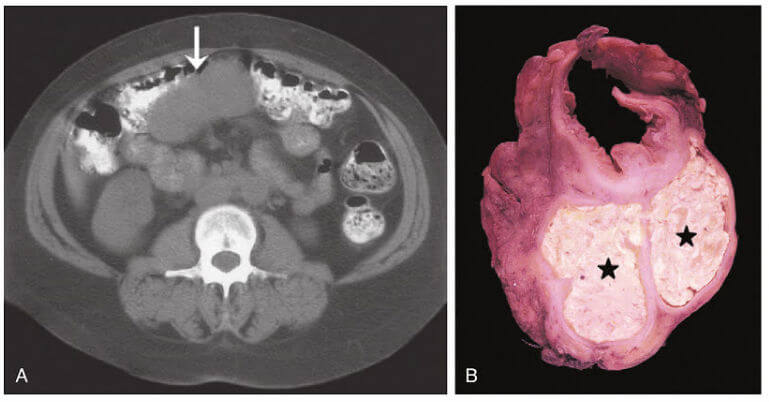
Uric acid lumps in the gut: Gouty Tophi in Colon.
 Keith TaylorParticipant
Keith TaylorParticipantGeneral discussion is for non-gout. How’s your family? Where’s this year’s holiday (vacation)? What does the Donald mean to you? That sort of thing.
But this topic is seriously gouty.
Anyway, I can’t remember the medical history of every member. So, I forgot about your thalassemia. Sorry, d_q! My immediate suggestion is (but see my last paragraph first):
1. Get a pill cutter (UK Amazon link that will earn me about 5p if you use the link. So, don’t worry if you have a different source)
2. Start febuxostat as soon as pill-cutter arrives.
3. After 2-4 weeks get a uric acid blood test and the usual kidney function and liver function tests.I realize it can be worrying to think about potential liver effects of febuxostat. But, it’s a rare occurrence. Medicine for complex cases is challenging. But, we’re lucky to live in an age with different options.
Finally, reading between the lines, am I right in thinking you are off allopurinol at the moment, d_q? If so, it might be a very good idea to get a 24-hour uric acid excretion test. Because, if your uric acid excretion rate is low, it can often be fixed with probenecid.
 Keith TaylorParticipant
Keith TaylorParticipantSorry for arriving late, d_q. I thought this was just a general chat and I was waiting for some spare time. Anyway, I’ve changed the title and moved it here from General Discussion.
I’m concerned about a few points. But, I need to go more research on hemoglobin and gout before I can say much meaningful. In particular, I’m in the dark about what constitutes a safe hemoglobin level. Because I’ve been bitten badly by normal values related to uric acid.
I can see that male values should normally be between 130 and 180 g/L. But, safe levels are harder to determine. So far, I’ve seen one report that suggests 120 is not a real concern. In the hemoglobin and allopurinol report, the data shows higher levels than that. Also, hemoglobin appears to rise again after 3 months.
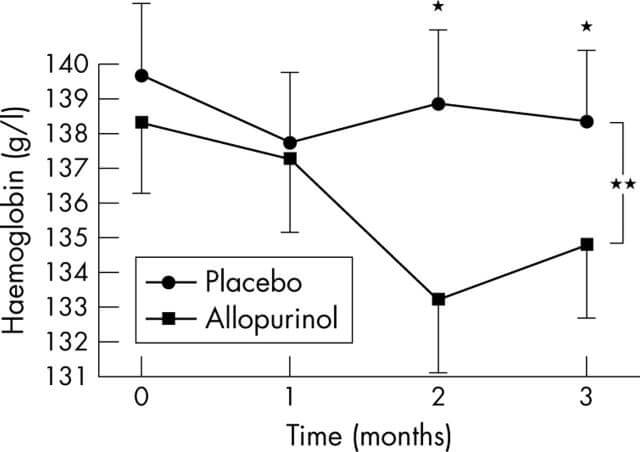
What level of hemoglobin is safe?
So question one is: is your hemoglobin a real issue? Or a temporary blip?
I.e. what hemoglobin history have you got?
Obviously, if you are in danger of anemia, you have to take action. But, I’m concerned that if this is only a short-term issue, with little consequence, you risk throwing out the baby with the bathwater.As for Adenuric, I also can’t locate 40mg in England. But, I saw a hint that Scotland has it (so far unconfirmed). The main problem reported with febuxostat relates to liver problems. But, if you get liver function tests, alongside uric acid tests, it is quite easy to monitor this.
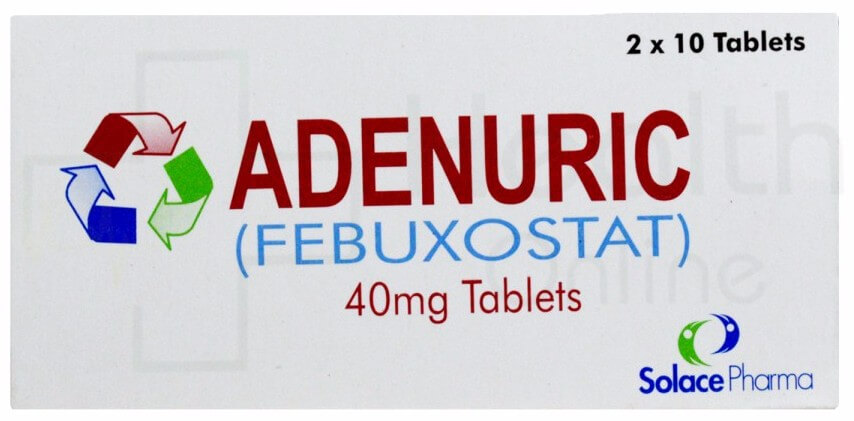
Is Adenuric 40mg (febuxostat) available in UK?
-
AuthorPosts
